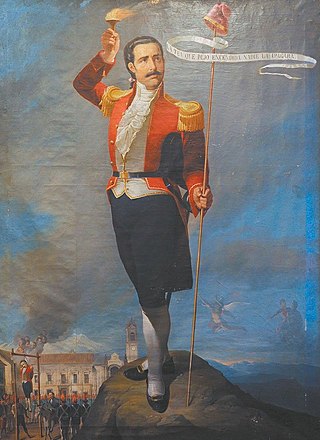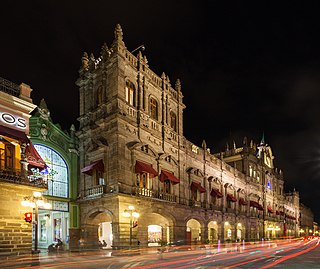
The Archdiocese of Puebla de los Ángeles is a Latin Church ecclesiastical territory or archdiocese of the Catholic Church. It is the oldest Catholic diocese in Mexico. It was established on October 13, 1525 as the "Diocese of Tlaxcala" and retained that name until it was elevated to an archdiocese in 1903. In 1959 a new Diocese of Tlaxcala was created and is suffragan to the Archdiocese of Puebla de los Ángeles.

Pedro Domingo Murillo is a province in the Bolivian La Paz Department. It was created on January 8, 1838, with the name Cercado and on October 17, 1912, during the presidency of Eliodoro Villazón, its name was changed in honor of Pedro Domingo Murillo, protagonist of the revolution of June 16, 1809.

Pedro Domingo Murillo was a patriot of Upper Peru who played a key role in Bolivia's independence.
Ixtlahuaca de Rayón is the municipal seat and 5th largest city in the municipality of Ixtlahuaca north of Toluca in the northwest part of the State of Mexico, in Mexico. The distance between Mexico City and Ixtlahuaca is 32 km. The name Ixthahuaca comes from Náhuatl and means plains without trees. The city and municipality were officially established by decree on November 14, 1816 by the Congress of the State of Mexico.

Santo Domingo in Mexico City refers to the Church of Santo Domingo and its Plaza, also called Santo Domingo. Both are located three blocks north of the Mexico City Metropolitan Cathedral following República de Brasil Street with Belisario Dominguez Street separating the two.

Achocalla Municipality is the third municipal section of the Pedro Domingo Murillo Province in the La Paz Department, Bolivia. Its seat is Achocalla or Achuqalla in the native language.

El Alto Municipality or El Alto de La Paz Municipality is a municipal section of the Pedro Domingo Murillo Province in the La Paz Department, Bolivia. Its seat is El Alto, the second-largest city in Bolivia.

Achocalla or Achuqalla is a location in the La Paz Department in Bolivia. It is the seat of the Achocalla Municipality, the third municipal section of the Pedro Domingo Murillo Province.
Mecapaca is a location in the La Paz Department in Bolivia. It is the seat of the Mecapaca Municipality, the second municipal section of the Pedro Domingo Murillo Province.
Palca, Bolivia is a location in the La Paz Department in Bolivia. It is the seat of the Palca Municipality, the first municipal section of the Pedro Domingo Murillo Province.

The city of La Paz, in the region of Upper Peru, experienced a revolution in 1809 that deposed Spanish authorities and declared independence. The revolution is considered one of the early steps of the Spanish American Wars of Independence and a predecessor of the Bolivian War of Independence. However, the revolution was defeated shortly it had started, and the city returned to Spanish rule.

La Paz was founded in 1548 by the Spanish conquistadors at the site of the Native American settlement Laja; the full name of the city was originally Nuestra Señora de La Paz. The name commemorated the restoration of peace following the insurrection of Gonzalo Pizarro and fellow conquistadors four years earlier against Blasco Núñez Vela, the first viceroy of Peru. The city was later moved to its present location in the valley of Chuquiago Marka.

The Plaza Murillo is the central plaza of the city of La Paz and the open space most connected to the political life of Bolivia. Prominent buildings on the plaza include the Presidential Palace, National Congress of Bolivia, and the Cathedral of La Paz. It is located in the old town, or Casco Viejo, of the city and is surrounded by Socabaya Street to the west, Ayacucho Street to the east, Comercio Street to the south, and a continuation of Ingavi and Ballivan Streets to the north.

Sirk'i Qullu is a mountain in the Cordillera Real in the Andes of Bolivia, about 5,546 m (18,196 ft) high. It is located in the La Paz Department, at the border of the Pedro Domingo Murillo Province, La Paz Municipality, and the Sud Yungas Province, Yanacachi Municipality. Sirk'i Qullu lies north-east of the city of La Paz, north of the mountain Jathi Qullu and south of the mountains Wak'ani and Mik'aya.
Urqu Jawira is a river in Bolivia in the La Paz Department, Pedro Domingo Murillo Province. It originates in the Wayllari mountain range. On its way to Choqueyapu River it crosses the city La Paz from north to south in the Putu Putu or Miraflores district.

Parque América is a park in Mexico City's Polanco neighborhood, in Mexico.

The bust of Plácido Domingo is installed outside the Teatro Principal in Puebla's historic centre, in the Mexican state of Puebla. The sculpture was unveiled in 2017.
Murillo is a Spanish surname. Notable people with the name include:

The historic centre of Puebla was declared a World Heritage Site by UNESCO in 1987.












